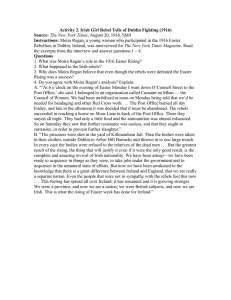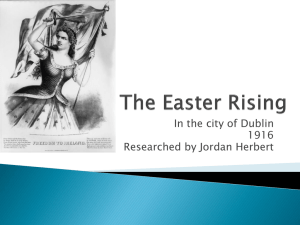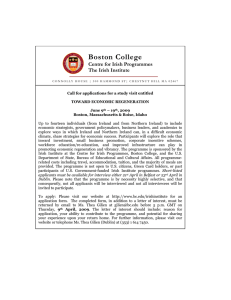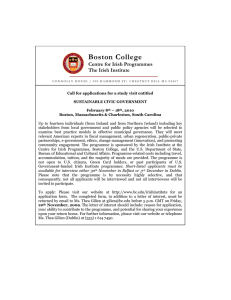The 1916 “Easter Rising” and Irish Independence
advertisement
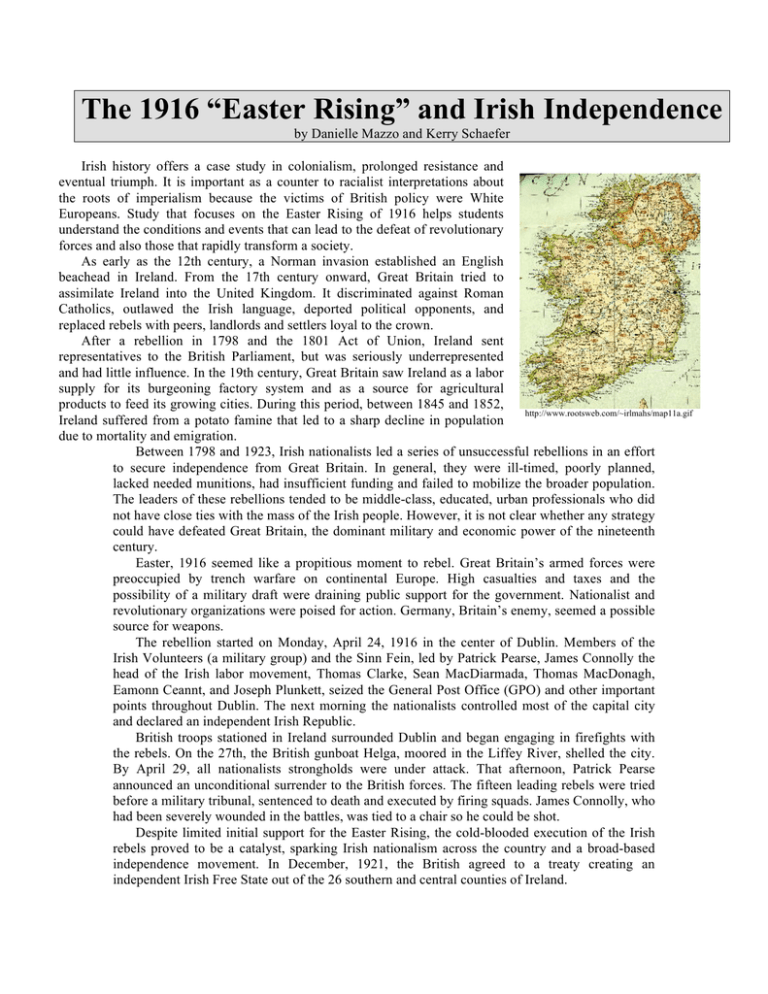
The 1916 “Easter Rising” and Irish Independence
by Danielle Mazzo and Kerry Schaefer
Irish history offers a case study in colonialism, prolonged resistance and
eventual triumph. It is important as a counter to racialist interpretations about
the roots of imperialism because the victims of British policy were White
Europeans. Study that focuses on the Easter Rising of 1916 helps students
understand the conditions and events that can lead to the defeat of revolutionary
forces and also those that rapidly transform a society.
As early as the 12th century, a Norman invasion established an English
beachead in Ireland. From the 17th century onward, Great Britain tried to
assimilate Ireland into the United Kingdom. It discriminated against Roman
Catholics, outlawed the Irish language, deported political opponents, and
replaced rebels with peers, landlords and settlers loyal to the crown.
After a rebellion in 1798 and the 1801 Act of Union, Ireland sent
representatives to the British Parliament, but was seriously underrepresented
and had little influence. In the 19th century, Great Britain saw Ireland as a labor
supply for its burgeoning factory system and as a source for agricultural
products to feed its growing cities. During this period, between 1845 and 1852,
http://www.rootsweb.com/~irlmahs/map11a.gif
Ireland suffered from a potato famine that led to a sharp decline in population
due to mortality and emigration.
Between 1798 and 1923, Irish nationalists led a series of unsuccessful rebellions in an effort
to secure independence from Great Britain. In general, they were ill-timed, poorly planned,
lacked needed munitions, had insufficient funding and failed to mobilize the broader population.
The leaders of these rebellions tended to be middle-class, educated, urban professionals who did
not have close ties with the mass of the Irish people. However, it is not clear whether any strategy
could have defeated Great Britain, the dominant military and economic power of the nineteenth
century.
Easter, 1916 seemed like a propitious moment to rebel. Great Britain’s armed forces were
preoccupied by trench warfare on continental Europe. High casualties and taxes and the
possibility of a military draft were draining public support for the government. Nationalist and
revolutionary organizations were poised for action. Germany, Britain’s enemy, seemed a possible
source for weapons.
The rebellion started on Monday, April 24, 1916 in the center of Dublin. Members of the
Irish Volunteers (a military group) and the Sinn Fein, led by Patrick Pearse, James Connolly the
head of the Irish labor movement, Thomas Clarke, Sean MacDiarmada, Thomas MacDonagh,
Eamonn Ceannt, and Joseph Plunkett, seized the General Post Office (GPO) and other important
points throughout Dublin. The next morning the nationalists controlled most of the capital city
and declared an independent Irish Republic.
British troops stationed in Ireland surrounded Dublin and began engaging in firefights with
the rebels. On the 27th, the British gunboat Helga, moored in the Liffey River, shelled the city.
By April 29, all nationalists strongholds were under attack. That afternoon, Patrick Pearse
announced an unconditional surrender to the British forces. The fifteen leading rebels were tried
before a military tribunal, sentenced to death and executed by firing squads. James Connolly, who
had been severely wounded in the battles, was tied to a chair so he could be shot.
Despite limited initial support for the Easter Rising, the cold-blooded execution of the Irish
rebels proved to be a catalyst, sparking Irish nationalism across the country and a broad-based
independence movement. In December, 1921, the British agreed to a treaty creating an
independent Irish Free State out of the 26 southern and central counties of Ireland.
!"#$%&'()*+#,&(-)./&)0102)34+5(&6)7858'9:)+';)<685/)<';&=&';&'#&)
<'(6";$#(8"'-!"#$%!&'()*+,-./0%+&!+%%01!$%!/0%+&!',!-#+!0(('*20,1$,3!&'()*+,-%!45.678!9-!$%!&+%$3,+&!-'!-+%-!
1'):!0/$;$-1!-'!<':=!<$-#!#$%-':$(0;!&'()*+,-%8!>'*+!'?!-#+!&'()*+,-%!#0@+!/++,!+&$-+&8!A%!1')!0,0;1B+!-#+!
&'()*+,-%C!-0=+!$,-'!0(('),-!/'-#!-#+!%'):(+!'?!+0(#!&'()*+,-!0,&!0,1!2'$,-!'?!@$+<!-#0-!*01!/+!2:+%+,-+&!$,!
-#+!&'()*+,-8!
Historical Context: The 1916 Easter Rising was a rebellion by Irish nationalists against British rule. During
the rising, rebels took over key locations in Dublin, Ireland and called for a broader revolution that did not
occur. Although the rebellion was militarily unsuccessful, it sparked growing feelings of Irish nationalism
that eventually led to Irish independence.
Task: Using information from the documents and your knowledge of global history, answer the questions that
follow each document in Part A. Your answers to the questions will help you write the Part B essay, in which you
will be asked to:
Explain why Irish nationalists staged the Easter Rising against British rule.
Describe the events that took place.
Evaluate the success and failure of the Easter Rising
Note: Be sure to use specific evidence sited in the documents as well as outside knowledge about global history.
The movie, Michael Collins (1996, starring Liam Neeson), is primarily about the civil war
that followed the establishment of the Irish Free State. Its opening scene depicts the Easter
Rising. It can provide students with a visual sense of Ireland and Dublin during this time period.
1. Chronology of Irish Rebellion
1798. Rebellion inspired by American and French Revolutions. In response, Britain dissolves 500
year old Irish Parliament.
1803. Revolt following the 1801 Act of Union absorbing Ireland into the United Kingdom.
1845-1852. Great Irish Famine. Millions die or go into exile.
1848. Desperate revolt spurred by failure of Great Britain to provide adequate famine relief.
1867. Fenian Uprising with support from Irish emigrants in the United States.
1880-1882. Waive of evictions by landlords of tenant farmers leads to another unsuccessful
rebellion.
1916. World War I era Easter Rising.
1921. Irish Free State established. Britain relinquishes control over all of Ireland except 6
counties in the north.
2. Chronology of the 1916 Easter Rising
April 24. The 1916 Rising begins in Dublin at noon.
2,000 men lead by Padhraic Pearse seize control of the
Dublin General Post Office. Leaders of the rebellion
proclaimed the Independence of Ireland and announced
the provisional government of the Irish Republic.
April 25. Rebels control a considerable part of Dublin.
British reinforcements arrive. Martial law declared.
April 26. Rebels now outnumbered 20 to 1. British
destroy headquarters of the Labor Party and trade
unions. St. Steven’s Green cleared of rebels.
April 27. General Sir John Maxwell arrives as the new
British commander in-chief with orders to put down the
rebellion as quickly as possible. The gunboat Helga
Dublin monument to James Connolly and martyrs of
shells Dublin from the Liffey River. There are hundreds the 1916 Easter Rising.
of civilian casualties in the city.
April 28. The GPO is on fire. James Connolly orders women to abandon the building. Final battle
is fought in King’s Street.
April 29. Under heavy attack, rebel leaders in the GPO surrender unconditionally. Sixty-four
rebels and 132 British soldiers are dead.
May 3-12. Fifteen leaders of the uprising were tried before a military tribunal and executed by
firing squad.
3. Proclamation from the Provisional Government of the
Irish Republic to the People of Ireland.
“Ireland, through us, summons her children to
the flag and strikes for her freedom. . . The Irish
Republic is entitled to, and hereby claims, the
allegiance of every Irishman and Irishwoman. The
Republic guarantees religious and civil liberty, equal
rights and equal opportunities to all its citizens. . .
cherishing all the children of the nation equally, and
oblivious of the differences carefully fostered by an
alien Government , which have divided a minority
from the majority in the past.”
1. What did the leaders of the rebellion declare?
2. In your opinion, why did they believe people would
support the proclamation?
>?)4@#&6=()A6"%)4+5(&6B)0102)CD)E?)F?)G&+(5)
(Source: http://www.online-literature.com/yeats/779/)
Too long a sacrifice
Can make a stone of the heart.
O when may it suffice? . . .
What is it but nightfall?
No, no, not night but death;
Was it needless death after all?
For England may keep faith
For all that is done and said.
We know their dream; enough
To know they dreamed and are dead;
And what if excess of love
Bewildered them till they died?
I write it out in a verse MacDonagh and MacBride
And Connolly and Pearse
Now and in time to be,
Wherever green is worn,
Are changed, changed utterly:
A terrible beauty is born
1. What “sacrifice” and “love” does Yeats describe?
2. What is the “terrible beauty” that was born?
5. London Had Heard Rumors (The New York Times, April 27, 1916)
“For some time, rumors of impending trouble have been in London. The Irish papers
have printed information of an alarming character. Although the London papers generally
refrained from or were not allowed to print news of this nature from Dublin, The Times
about ten days ago gave a half-column report from its Dublin correspondent of the seditious
movement there. In the early part of last week, the New York Times correspondent heard
reports that an Irish rebellion was timed to break out between Good Friday and Easter
Monday. These reports were spread broadcast and it was naturally assumed that the
Government was in possession of all the facts requisite to place it in full position to keep
matters well in hand. Among members of Parliament there was a widely spread idea that a
strict investigation must be made.”
1. According to The New York Times, why should the British government have been prepared
for the rebellion?
6. Martial Law Curbs Ireland; Rebels in Trap (The New York Times, April 28, 1916)
“British regulars from Belfast and England are now in Dublin and have recaptured from the
revolutionary faction several important centers which the members of the Sinn Fein party had
occupied. These include Stephen’s Green, Liberty Hall and the GPO. Martial law has been
proclaimed in the city and country of Dublin and the official announcement is made that drastic
steps are being taken to suppress and arrest all those responsible. The associations which
participated in the revolt are proclaimed illegal.
That the Government intends to deal with the offenders with a heavy hand, as indicated by
the publication of a proclamation in the official Gazette tonight, suspending the Defense of the
Realm Amendment act of 1915, which gives to a British subject charged with an offense under
the act, the right to be tried by a civil court. The proclamation recites that “the present state of
affairs in Ireland is such as to constitute a special military emergency.”
1. What happens when British troops arrive in Dublin?
2. In your opinion, why was martial law declared and the right to a civil trial revoked?
7. A Rebel Speaks at his Court Martial
Patrick Pearse was born September 10, 1879 in Dublin. He was
a member of the Irish Bar and of the Central Council of the
Irish Volunteers, Commandant General of the Army of the Irish
Republic and President of the Provisional Government. He was
tried by court martial on May 2, 1916 and executed by firing
squad the next morning between 3:30 and 4AM at Kilmainham
Prison. At his trial he made the following statement:
I assume I am speaking to the Englishmen who value their
own freedom, and who profess to be fighting for the freedom of
Belgium and Serbia. Believe that we too love freedom and
desire it. To us it is more desirable than anything else in the
world. If you strike us down now we shall rise again and renew
the fight. You cannot conquer Ireland; you cannot extinguish
the Irish passion for freedom; if our deed has not been sufficient
to win freedom then our children will win it by a better deed.
My sole object in surrendering unconditionally was to save
the slaughter of the civil population and to save the lives of our
followers who had been led into this thing by us. It is my hope
that the British Government who has shown its strength will
also be magnanimous and spare the lives and give an amnesty
to my followers. . . .
I am prepared to take the consequences of my act, but I
should like my followers to receive an amnesty. I went down on
my knees as a child and told God that I would work all my life
to gain the freedom of Ireland. I have deemed it my duty as an
Irishman to fight for the freedom of my country. I admit I have
organized men to fight against Britain.
The courtyard at Kilmainham Prison.
I admit having opened negotiations with
Germany. We have kept our word with her and
as far as I can see she did her best to help us. She
sent a ship with men. Germany has not sent us
gold.
1. Who was Patrick Pearse?
2. Why did he participate in the Easter Rising?
3. Do you believe he should have been
executed for treason? Explain.
H?)I"86+)7&9+'B)<685/)J86K)7&C&K).&KK5)"A)!$CK8')L89/(8'9)4!"#$%#&$'()*$!+,#-C!A)3)%-!DEC!5F5G7!
“At 6 o’clock on the evening of Easter Monday I went down O’Connell Street to the Post
Office,” she said. I belonged to an organization called Cumann na Mban—the Council of
Women. We had been mobilized at noon on Monday being told that we’d be needed for
bandaging and other Red Cross work.
“The Post Office burned all day Friday, and late in the afternoon it was decided that it must
be abandoned. The rebels succeeded in reaching a house on Moor Lane in back of the Post
Office. There they stayed all night. They had only a little food and the ammunition was almost
exhausted. So on Saturday they saw that further resistance was useless, and that they ought to
surrender, in order to prevent further slaughter.
“The prisoners were shot in the yard of Killmainham Jail. Then the bodies were taken in
their clothes, outside Dublin to Arbor Hill Barracks and thrown in to one large trench. In every
case the bodies were refused to the relatives of the dead men.
“But the greatest result of the rising, the thing that will justify it even if it were the only good
result, is the complete and amazing revival of Irish nationality. We have been asleep—we have
been ready to acquiesce in things as they were, to take jobs under the government and to
acquiesce in the unnatural state of affairs. But now we have been awakened to the knowledge that
there is a great difference between Ireland and England, that we are really a separate nation. Even
the people that were not in sympathy with the rebels feel this now.
“This feeling has spread all over Ireland; it has remained and it is growing stronger. We were
a province, and now we are a nation; we were British subjects, and now we are Irish. This is what
the rising of Easter week has done for Ireland.”
1. What was Moira Regan’s role in the Easter Rising?
Why does she feel the rising was a success?
